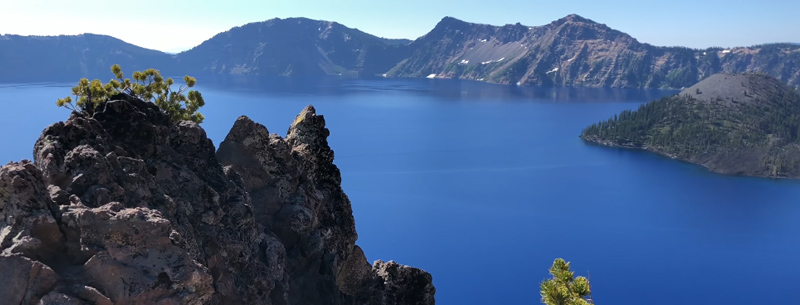For ages, Crater Lake has been a place of beauty and mystery. In 1902, it became one of America’s first national parks. Today half a million people visit the park every year, to gaze in awe at its beauty. Watching the moon reflect off the Lake is something everyone should try to do at least once in their lifetime.
Crater Lake’s significance began with the native inhabitants of southern Oregon, and it remains an important part of their culture. American settlers saw Crater Lake for the first time in 1853. As word spread, increasing numbers traveled to see the magnificent sights. In 1885, William Steel began a 17-year campaign to establish a national park.
Visitors find Crater Lake to be a source of endless mystery. Even in a realm of volcanic wonders, Crater Lake can exclusively be described in superlatives. Stories of the deep blue lake can never prepare sightseers for their first breathtaking look from the brink of the 6-mile wide caldera. The Lake was created by the eruption and collapse of Mount Mazama roughly 7,700 years ago. Even seasoned travelers gasp at the twenty-mile circle of cliffs, tinted in subtle shades and fringed with hemlock, fir, and pine: all this reflected in a lake of indescribable blue.
Crater Lake Trivia
- At 1943 feet deep, Crater Lake is the deepest lake in the United States and the seventh deepest lake in the world!
- Crater Lake lies inside a caldera, or volcanic basin, created about 7,700 years ago when the 12,000-foot high Mount Mazama collapsed following a major eruption.
- Because Crater Lake is filled nearly entirely by rainfall and snowmelt, it is one of the most transparent lakes anywhere in the world. Scientists, using a reflector called a Secchi disk, generally record clarity readings of 120 feet. On June 25, 1997, scientists reported a record clarity reading of 142 feet!
Crater Lake Attractions
The lake at the center of this national park was formed by the collapse of Mount Mazama. This volcanic crater has no inlet or outlet of water; the lake is kept full by annual snow melt. The park is open year round but access to activities such as swimming in the lake is limited to a few summer months due to the early snow fall. Throughout the winter snowshoe hikes led by rangers and cross country skiing are available; routes depend on the weather conditions at the time. At nearly 600m deep Crater Lake is the deepest in the United States.
- Take a car or bike ride on Rim Drive, which circles the caldera.
- Take a boat tour during the summer on the surface of the Lake.
- Stay in the beautiful, historic Crater Lake Lodge.
- Hike some of the park’s trails including Mt. Scott, the park’s highest peak at 8,929 ft.
- The winter brings some of the most substantial snowfall in the country, averaging 533 inches per year. Although park facilities often close for this snowy season, visitors may view the lake during fair weather, enjoy cross-country skiing, and engage in weekend snowshoe hikes.
